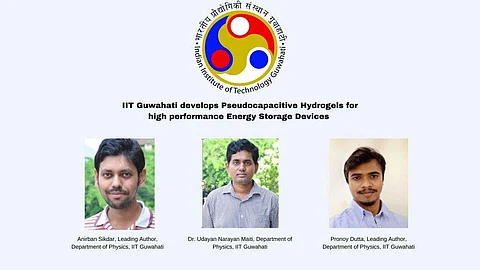

The batteries we function on all come with their own set of problems. Take the battery in your phone, for example. They can take anywhere between an hour to an eternity to charge, depending on how old or young your device is, and there are additional threats of overheating, or sometimes explosions because of how volatile and inflammable the electrolytes storing the charge can become, if exposed to the atmosphere.
Then there is the constantly depleting resources of lithium, which is one of the major components of these batteries. Supercapacitors have been around for some time now, and have simplified a few of these issues, including increased safety, and energy storage. However, this tech came with its own shortcomings, given the fact that they are energy-dense and involve large amounts of material to store the energy.
A research team from the the Department of Physics, IIT Guwahati has developed a Pseudocapacitor Hydrogel, which, according to chief investigator, Dr Uday Narayan Maiti is a parallel but safer technology when compared to commercial batteries. The research, which was crafted in collaboration with Prof Subhradip Ghosh, IIT Guwahati and Dr N Padma of the Physics group, Bhabha Atomic Research Centre (BARC), Mumbai, under BRNS (Board of Research in Nuclear Science) project was published in the journal Electrochimica Acta and Carbon. PhD scholars Anirban Sikdar and Pronoy Dutta from the Department of Physics, IIT-G were also significant contributors to the study.
“The surface area of the material is what holds the energy. The bulk of the material is of no use,” says Dr Uday. Nanosheets are two dimensional materials that are one billion times thinner than a single strand of hair. They have better surface-to-volume ratio in storing energy when compared to other materials used in batteries. However, nanosheets are miniscule— just about 10 microns in width, and that is nowhere near sufficient to hold any practical amounts of energy. And so they need to be stacked. “However, when they are stacked, they tend to stick to each other, which means that no ions can pass through, making them redundant,” says Dr Uday. This is the issue that the researchers at IIT-G tackled head on.
About a year in the making, the researchers have been working on synthesising materials for a hydrogel that can help the nanosheets stay connected without losing their ability to conduct energy. “We have connected them by using a water solution where a huge number of sheets are floating and we introduce a zinc metal plate within the solution. These sheets sit one upon another, and water molecules remain between the layers of the sheet so that they don't stick to each other. It is a stable structure and results in less restacking of the sheets,” explains Dr Uday.
This hydrogel material uses two kinds of sheets—graphene, which is made out of carbon, and mXene, which is a compound of titanium carbide. The mechanism by which ions can go inside the sheets to store the charge differs between these two types of sheets. With graphene, they just remain associated, and there is no chemical reaction, says Dr Uday. Whereas with mXene, they react with the surface and store energy, and this mechanism is known as pseudocapacitor.
Dr Uday says that synthesising of the materials for the hydrogel is what took the team this long. “Otherwise, if the technology is known to us, it is practically a matter of hours to develop the hydrogel,” says the researcher.
The technology has the capacity for some possibly significant usage. Solar cells need a backup that can store the energy they produce. The pseudocapacitor hydrogel can do that. Then it also has application as an energy source for hybrid vehicles, apart from being used in everyday portable electronics such as mobile phones,” shares Dr Uday.
There is still scope to enhance the energy density by tuning the electric properties to hold more charge. Dr Uday also adds that hydrogels as standalone materials also have an additional application as a water purifier since they are able to absorb pollutants from the water.
